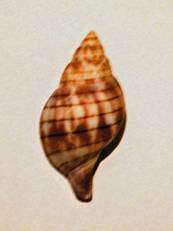- Tulip shell
Taxobox
name = Tulip shell, "Fasciolaria" sp.

image_width = 130px
regnum =Animalia
phylum =Mollusca
classis =Gastropoda
subclassis =Orthogastropoda
ordo =Sorbeoconcha
subordo =Hypsogastropoda
infraordo =Neogastropoda
familia =Fasciolariidae
genus = "Fasciolaria "The Tulip shell, scientific namegenus "Fasciolaria", is acommon name for twospecies of largepredatory subtropical andtropical seasnail s, marinegastropod mollusk s in the familyFasciolariidae , the spindle shells, tulip shells and their allies.The two tulip shells, "Fasciolaria tulipa" and "Fasciolaria lilium", are both western
Atlantic species.The name "tulip shell" is a description of the overall shape of the shells of these species, which is like that of a closed tulip flower.
The true tulip, "Fasciolaria tulipa"
Distribution
This species occurs from the
North Carolina coast all the way south and west to the Gulf coast ofTexas , also in theWest Indies .Habitat
"Fasciolaria tulipa" usually lives in sand or mud at approximately 30 feet depth.
hell description
The tulip shell is a white/tan with rows of darker brownish blotches of various sizes from the spire to the aperture. Over those are symmetrical rows of thin lines that spiral up the shell spaced at approximately every 1/8 inch.
The shell is 2.5” – 9.5” inches (6.4 – 24.1 cm) in length.
Prey species
This snail eats various other gastropods and bivalves, especially its cousin, the banded tulip.
The banded tulip, "Fasciolaria lilium"
Distribution
This species occurs from the Florida coast to the Gulf coast of
Texas , and down intoMexico .Habitat
"Fasciolaria lilium" is found in sand or muddy sand from 2 to 150 feet depth.
hell description
The banded tulip has a very similar color pattern to the true tulip. But the main differences are the color splotches appear as a redder color (blue in rare areas). Also the stripes that give the banded tulip its name are farther apart; closer to half a centimeter.
The shell is 2 ¼ - 4 1/8 inches (5.7-10.5 cm.) in length.
Prey species
Little is known about the banded tulip’s diet, but it is assumed that it is similar to that of the true tulip: small gastropods and bivalves.
References
* National Audubon Society Field Guide to North American Seashells
Wikimedia Foundation. 2010.
